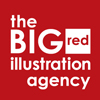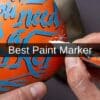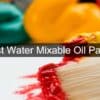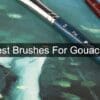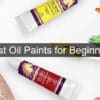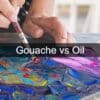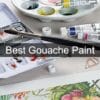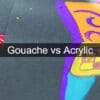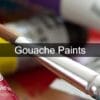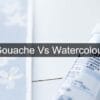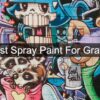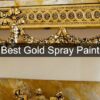Types Of Pastels

Pastels are one of the most commonly used mediums in the world of artists, and the reason behind it is simple. They are fun and easy to work with, making them accessible to both beginners and seasoned artists alike.
The soft pastel, hard pastel, and oil pastel are the most commonly used pastels in the realm of art supplies and we will be breaking down which does what and how you can exercise various techniques in your brilliant paintings.
In this guide we will be discussing the various types of pastels you can find in the market that you can add to your arsenal from student quality pastels to artist quality pastels for experienced artists.
Keep in mind that budget is also a thing to consider. Student quality pastels will contain cheaper pigments in comparison to actual artist quality pastels.
Artists have been working with countless numbers of media of paint since the dawn of time and so many artists actually prefer working with this medium among other art mediums due to the fact that they are extremely easy to get into allowing you to start drawing and painting with limited practice or knowledge straight away.
Pastels usually come in stick form unlike paint which allows you to get straight into your drawings, they can even come in pencil form for fine lines adding to the convenience of very little preparation required to get started.
And if you’re a fan of great vivid colors look no further than pastels as they contain pure pigment in them.
All you need is your pastels and pastel pencils and maybe pastel paper if you prefer or literally any other surface you want to get drawing on. Once again unlike other mediums of painting and drawing you require very little to get incredible artistic effects with the versatile techniques of pastel painting.
Disclaimer – This website contains affiliate links. If you find the information useful and click on a product link and make a purchase, a small commission will be earned by Big Red Illustration
Oil pastels

The pastels generally do not adhere to any surface that strongly but still stick better than soft or hard pastels. They are great for any surface such as colored paper, card stock, painting cardboard, canvas, watercolor paper, pastel paper, etc.
Oil pastels are usually made of pigment, binder, non-drying oil, and wax. The binder is made of wax and oil as opposed to the gum binder found in soft pastels.
Artists have a lot of fun working with oil pastels due to the nature of the pastels. They are great for blending and you can have a lot of fun with maybe a foam blender, a blending stump, or even get to work with your fingers.
The possibilities are endless when it comes to blending oil pastels as suggested before. Most people love the intense vibrancy of the colors and you are free to mix and match the hues to get stellar color combinations for your canvas.
The pigment in oil pastels gives an intense hue look while soft pastels tend to give out more subtle colors. So, it’s perhaps a little easier to have more expressive lines and paintings with the help of oil pastels.
Please note: You may need to overlap the pastel drawing with multiple layers for a more complete and opaque look.
Top Tip: Take your oil pastel painting to the next level by trying out various blend techniques on your art projects with your pastel paint set.
Oil pastels are generally acid-free. The nature of the paint will allow you to get handsy without having to worry about toxic chemicals. Something that artists love to do is get into their projects without having to worry about external effects.
Another thing to consider while working with oil pastels for your art projects is that the pigment is quite vibrant which would ensure you have brilliant expressive strokes, something that seasoned artists absolutely adore about oil painting.
Oil pastels are very much like oil paint and can be worked with minimal solvents achieving great results.
If you’re a fan of expressive painting, meaning you don’t really need a lot of fine intricate details on your painting, oil pastels are simply one of the best ways to achieve what you are imagining.
Oil pastel sticks come in large sets of pastel colors and are a lovely medium with their amazing waxy consistency and intense colors. The sticks are basically just pigment and a binder mixture of non-drying oil and wax.
Oil pastels, not to be confused with oil paint, have really intense hues but still require several layers of application for a fully opaque look.
Many artists use oil pastels for expressive and abstract paintings. This type of pastel is actually preferred if you are not really bothered about precise details and want more abstract-looking paintings with smudgy lines.
Oil pastels have some of the best pigments and have vivid colors upon application. Blending the oil pastels with other colors, however, may take a little bit of getting used to.
Oil pastel, like other types of pastel do not require you to invest in other tools, however, if you really want to get super experimental you may invest in other equipment (or use the ones present in your arsenal) for maybe blending and altering your paintings as most artists do.
Among pastels, oil pastels are a type of pastel that has a soft nature and are one of the most satisfactory ways to work when taking on pastel painting. Just bear in mind that you may have to layer colours for an opaque look, so you’ll have to apply several coatings on the same painting if that’s the finish you’re trying to achieve.
If you’re looking for more pigment and intense color among pastel types, oil pastels are the way to go for your art projects and overall a great medium to work with in terms of pigment intensity, texture and ease of use.
Soft pastels
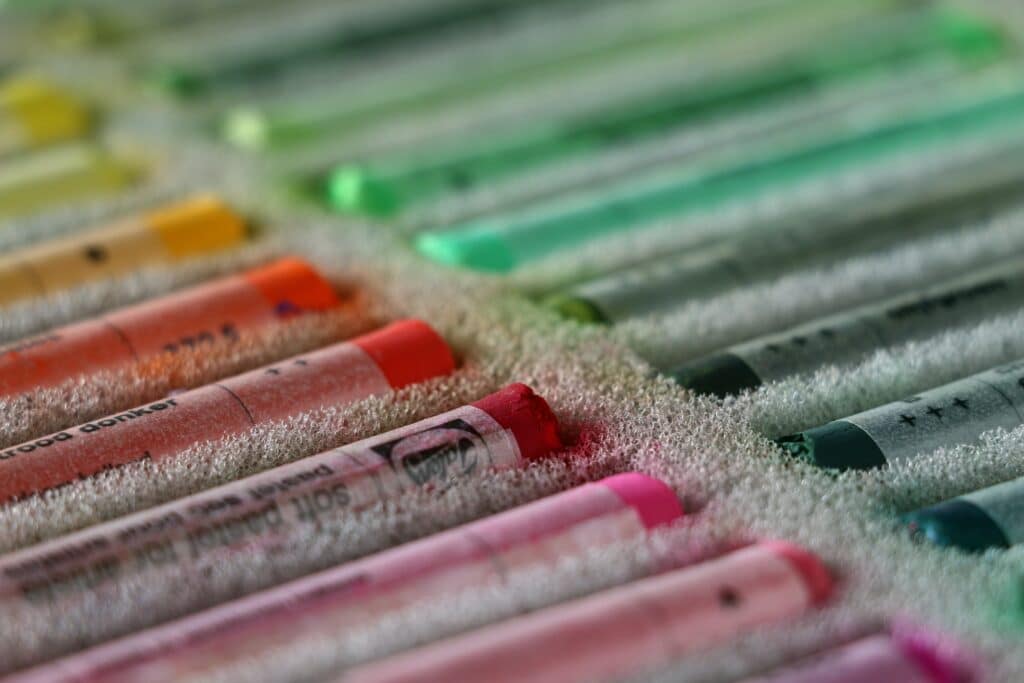
Soft pastels are a very popular selection among artists and are great and super easy to work with. You can blend the pastels really easily with your fingertips due to the soft consistency of the sticks. Thus entailing that you don’t really need any extra tools to work with on paper and other surfaces.
Soft pastels are one of the best pastels out there to start off with as a beginner looking to dive into the vast universe of this medium.
This medium, however, kicks up dust as the ingredients of each stick contains chalk, water, pigment and gum arabic. So, it is advised to work in a well-ventilated room or wear a respirator to avoid inhaling the chalk which may be harmful to do so.
Soft pastel sticks have less binder compared to oil pastels which make the sticks more fragile and breaks apart really easily. The adherence of the medium is subpar and is prone to smudging. Thus creating smudgy lines.
Soft and hard pastels have very similar features due to the same ingredients being present in the sticks, however, they are not to be confused with being the same medium.
Various online suppliers have amazing selections of pastel manufacturers and brands. Rembrandt and Unison offer great options for starters and the Unisons landscape set is the perfect example for a beginner set as suggested by many experienced artists.
Soft pastels have a soft texture that breaks apart really easy which in turn allows them to be moved across your surface without effort. They fall under the water-soluble pastels category and while they do not have the highest pigment concentration, they still have decent amounts of pigment and are great for blending.
Hard pastels

Soft and hard pastels have very similar ingredients, however, they are very different in terms of application and use.
While you have less pigment in hard pastel, it makes up for itself by containing more binder as opposed to soft pastel, thus making them harder to break and fall apart.
Hard pastels are good for more bold lines and details and you can even use them to fix soft pastels in place while using them in the same drawings.
Due to the nature of the ingredients and application process being dry, you are free to easily blend with other mediums such as water color and gouache as opposed to oil pastels.
Hard pastel sets come in large sets similar to soft pastels which allow you to have a very versatile set of paint collections for your art – good artist quality pastels are always a great addition.
You can easily take your art to the next level with hard pastels due to their tougher nature with more binder which allows you to create details without having your stick break apart.
Pastel pencils
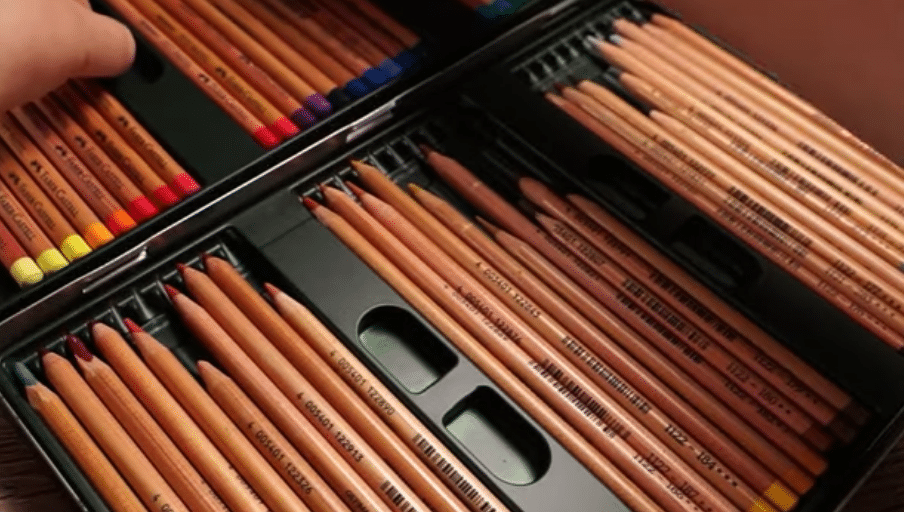
Pastel pencils are the better part of soft pastels if you want to cut out the chalk kicking up. You will not face the dust problem due to the fact that it comes out of a thin tip similar to colored pencil.
Pastel pencils are basically pastel encased in woodstick similar to color pencils making them super easy to grab and draw. You don’t get the same results, however, as pastels have more opaque colors due to increased pigment.
While they are not exactly the same as soft pastels they are quite similar and can be used together with the soft pastels for outstanding results. You can use the pastel pencils for hazy lines with a blunt tip or fine details with sharp tips enabling you to have increased control.
Pastel pencils can be great for thin lines, fine details and preliminary sketches on paper. Unlike colored pencils, they are more opaque and can be layered and allow you to blend to shade for a unique and beautiful finish for your art.
Additionally, much like other types of pastels, pastel pencils are pigment bound. Other pastels types simply won’t be able to give better results in the details than pastel pencils for your pastel drawing.
Overall, this type of pastel can bear you amazing results if used correctly and even as a beginner you’ll benefit from experimenting freely with them.
Pan pastels
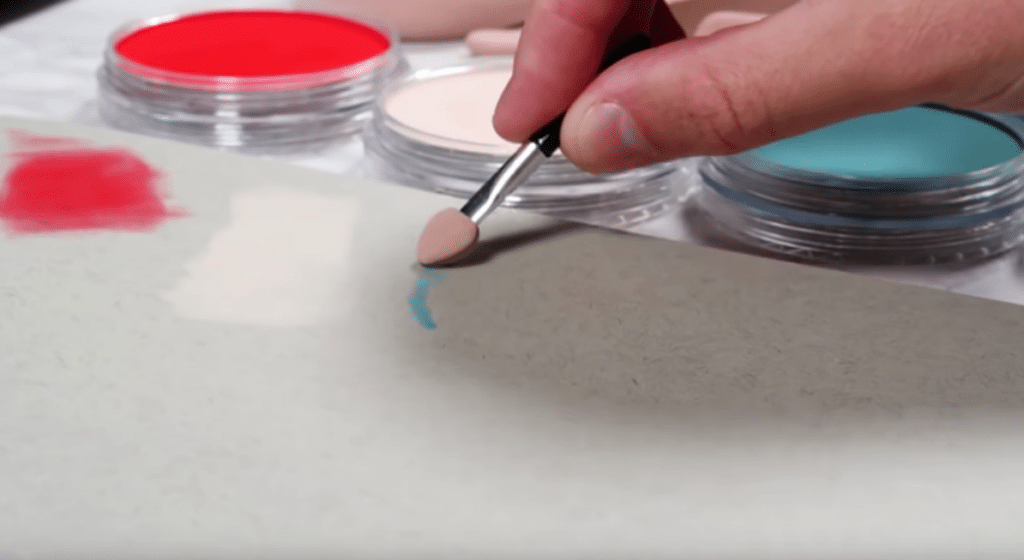
Pan pastels are unique to other types of pastels as they are probably the only ones that do not come in a form that is not a stick.
They are used for painting, drawing and mixed media and contain minimal binder and fillers. What does that entail for the quality and feel of pan pastels? Well, due to the limited amount of binders and fillers, it’s the pigments that ensure the super-rich and blendable colors.
Among pastel types, pan pastel holds the title of the most vibrant colors provided during application. This has the best of oil paints, oil pastels and hard pastels all in one medium.
Pan pastels are a relatively newer type of pastel that falls easily between the best of both worlds which are water color and soft pastel. It even looks like a watercolor set with the colors moulded into a pan as you would see in conventional pan sets.
You would need some preparation, however, in terms of equipment such as a palette and blending stump as opposed to using oil or soft pastel.
Additionally, a brush is very necessary as the medium being offered is not in stick form so you can’t really get to drawing right away.
The pigment present in this medium is more prominent than soft and oil pastel making them highly desirable in the artists’ community.
Overall, if you look beyond the fact that it’s not as convenient as the other pastels, you can make amazing masterpieces out of this medium.
Affordability and availability
Soft pastels, oil pastels, hard pastels and pastels, in general, are a great medium for all artists spanning from amateur artists to seasoned veterans. However, often a major concern for anybody in the art scene is the pricing of these mediums.
The pricing of what you’re looking for depends on the pastel brands and the number of pastel sticks present in one set. The sets being offered on the market can come in collections of 12 up to well over 100 even.
The price gap between oil and soft pastels are minimal allowing you the freedom to be able to afford whichever you desire.
Cheap pastels with cheaper pigments are a great place to begin if you want to start with pastels and on a budget. Whether you start with soft pastels or oil pastels doesn’t really matter in this case as the point is to test the waters with the most generic pastels before you find what is best for your ease and suitability for your projects.
Conclusion
Pastels are very versatile and offer some of the best value for money sets with all the color selections they have to offer in their packs. Considering all the features and budgeting, you will definitely not regret working with pastels.
The variety of pastels in the market will certainly have you occupied far beyond your expectations. It’s always best to keep in mind to try out as many of the different pastels the market has to offer as you never know what the best fit will be for you.
To conclude the world of pastels is huge so it’s okay to take your time finding what the best option for you is, even if it takes a little bit out of your bank along the way.
Rest assured, you’ll be out there making amazing creations in no time.
Affiliate Disclosure
In compliance with the FTC guidelines, please assume the following about all links, posts, photos and other material on this website: Any/all of the links on this website are affiliate links of which The Big Red Illustration Agency receives a small commission from sales of certain items, but the price is the same for you. www.bigredillustrationagency.com is a participant in the Amazon Services LLC Associates Program, an affiliate advertising program designed to provide a means for sites to earn advertising fees by advertising and linking to Amazon.com & Amazon.co.uk. Pages on this site may include links to Amazon and its affiliate sites on which the owner of this website will make a referral commission.
FULL TERMS HERE Cookie preferences: cookie preferences
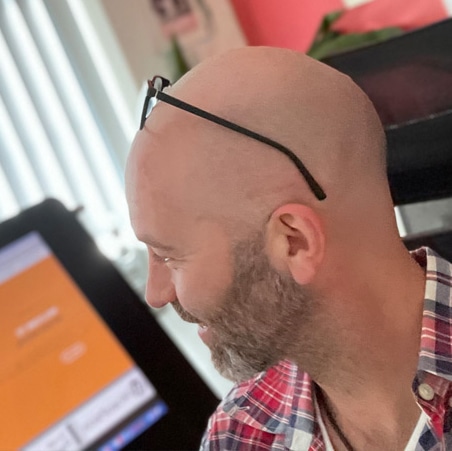
Written By Adam Rushton
Adam has made a name for himself in the illustration industry and is a passionate blogger and writer on the subject of art, illustration and graphic design.
His artwork has been featured in countless publications and used for very well-known media projects. As a professional illustrator for over 20 years, Adams media outlets, a wealth of knowledge, and experience enable him to consult and advise artists and illustrators in this country (from York and Manchester to Southampton and London) and all over the world.
